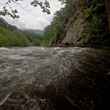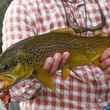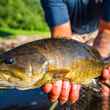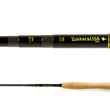Most certainly this was the first fly fishing tactic. At its genesis, fly fishing was a hunter/gatherer tactic, not a sport, although I suspect that its first practitioners found it to be just as much fun as those of us that have ever caught a fish on a fly that he/she tied. It was not practiced with a rod and reel and line and leader; it was very much a "pole and (horse-hair) string" business. There was no shooting line, no double haul, not even any real "casting" per se. It was just a "flop it out there" process, with perhaps the occasional dapping. The currents would have dragged the fly almost instantly, but that could have been an effective method when the fish were taking adult caddis and midges, which the first recorded fly design seems to have suggested.
From the vantage point of long flies -- minnows and leeches, frogs and mice, poppers and gurglers, tubes and hair bugs and so on -- it is with these imitations that the down-and-across swing really shines, because while drag is a nuisance with dead-drifted dries, emergers and other flies of the film, drag can definitely be the long-fly fisher's friend.
As the name clearly indicates, the fly is presented to the fish on a down-and-across cast; typically a 30- to 45-degree angle downstream. The currents are then allowed to swing the fly back across stream until it is hanging straight downstream from the caster. It's a very easy tactic that can yield surprisingly good results. I especially like this tactic in smaller streams that I can easily cast across. I put the fly as tight to the far bank as possible -- right onto the shore if that's feasible -- and allow it to drag across. If there are fish in the near-shore waters along the far bank, they'll hit the fly as it drops into the water and heads off across stream. If there are fish along the angler's bank, they come running as the imitation shoots out of the mid-stream currents and into the quiet shallows.
In that regard, don't recast your down-and-across delivered fly too soon. It's always a good bet to allow the fly to hang for a few seconds or even strip it upstream a couple of feet before picking it up to cast again. In his magnum opus, Trout, Ernie Schweibert relates a great story about fishing with Joe Brooks on the Yellowstone. The aspen were in their fall yellows, the browns were in the nuptial finery, and Joe and Ernie were levering big Muddlers into the heavy currents of the Yellowstone. As Ernie began to wade down, Joe cautioned him to watch the shallows carefully and not neglect to fish them thoroughly. Sure enough, the warning came just in time and a heavy fish grabbed the Muddler with a decisive lunge.
As the story goes, it fought deep and hard, ripping off great lengths of line, which it yielded back only with belligerent head shakes and dogged twisted and turning. The little trout rod that Ernie was using had the spine of a kitten, and he needed a tiger. Finally, the fish pulled free of the hook and headed back to more amorous pursuits.
The down-and-across swing is also used for wet flies and some nymphs. The nymph and long fly tactic uses a nymph or wet fly as the lead fly with a long fly 18 to 24 inches behind it. Seems a bit odd, but it works. For example, a Woolly Worm as the lead fly and a Black-Nose Dace bucktail as the trailing fly. In his book, The Practical Fly Fisherman, A. J. McClaine points out:
"It is generally understood that this represents a minnow chasing an insect as the cast is drawn through the water. However, the fish don't always follow the logical sequence of grabbing the bucktail and then the wet fly. Often as not, they dash ahead of the 'minnow' and take the insect."
There are also plenty of times when I will fish two long flies, one behind the other. On occasion, they will be the same fly, but often I'll use two different imitations to "give 'em a choice." It catches fish. Try the two-fly combo with all the long-fly tactics, not just the down-and-across swing.
Editor's Note: The above is an excerpt from "Long Flies", by Gary Borger. It is the third book in Gary's "Fly Fishing: The Book Series". As we've noted before, if you're not familiar with the series, you're missing out. Each book is a fountain of information resulting from years of well-heeled experience. The books offer a bevy of knowledge. Most importantly, the lessons in the book are illustrated by warm, entertaining anecdotes from Gary Borger's life as a fisherman, making the books not only valuable tools for the fly fisherman, but an absolute pleasure to read. To learn more about the entire series, visit GaryBorger.com.































Comments
ginkthefly replied on Permalink
There's a reason they say "the tug is the drug" ... unquestionably my favorite way to catch fishes.
Chad Shmukler replied on Permalink
And particularly so with trout. When you're after bass or saltwater fish, for instance, seeing their raw predatory instincts is typical. With trout, even though trout sipping emergers or lazily rising for dries is of course predatory behavior, it doesn't have the same aggressive feel that a fish chasing down a streamer does. For me, at least, that's where the fun comes in -- though I suspect that's everyone else's draw to swinging flies as well.
Mike Sepelak replied on Permalink
My favorite technique as well, though I have not tried doubling up on the "long fly". Thanks for the suggestion!
Chad Shmukler replied on Permalink
Likewise, Mike. I've thought about doing it countless times -- as I virtually never fish anything but a double or triple nymph rig -- but always dismiss it as ridiculous.
No longer. More flies = more chances to fool fish.
mkjames replied on Permalink
A favorite small-stream tactic, now that's helpful. I so typically think of not only swinging flies -- but streamers in general -- as big water tactics. I guess I need to start using them on small streams more often.
This is exciting. :=)
Pages